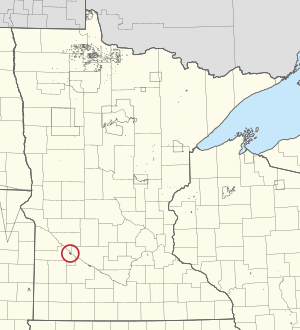Upper Sioux Indian Reservation facts for kids

Location of Upper Sioux Community
|
|
| Total population | |
|---|---|
| 482 enrolled members | |
| Regions with significant populations | |
The Upper Sioux Indian Reservation is a special area of land in Minnesota. Its name in the Dakota language is Pezihutazizi. This reservation is home to the Upper Sioux Community. This community is a federally recognized tribe of the Dakota people, which includes the Mdewakanton group.
The Upper Sioux Indian Reservation is located in Minnesota. It is in Minnesota Falls Township, right along the Minnesota River. You can find it in eastern Yellow Medicine County, Minnesota, about 5 miles south of Granite Falls. The reservation was created in 1938. At that time, the federal government gave back 746 acres of land to the tribe. This happened under the Indian Reorganization Act, which helped tribes govern themselves.
In 2020, about 120 people lived on the reservation. Its total land area is about 2.3 square miles. This includes some land held in trust for the tribe outside the main reservation. The Upper Sioux Community runs the Prairie's Edge Casino Resort. Every August, the community holds its traditional Pejhutazizi Oyate wacipi, which is a type of pow-wow.
Contents
History of the Upper Sioux Community
This reservation was first set up for the Wahpeton and Sisseton bands of the Upper Dakota. In 1851, a treaty with the United States, called the Treaty of Traverse des Sioux, created this land. It was about 20 miles wide and 70 miles long along the Minnesota River.
After the Dakota War of 1862, the U.S. government punished the Dakota people. They made the reservations along the river much smaller. This was an attempt to make the Dakota leave the area. Many people did move west, and their descendants now live on reservations in South Dakota.
In 1938, the federal government returned 746 acres of land to the tribe. Most of the tribe members did not have land at that time. This action was part of the Indian Reorganization Act. President Franklin D. Roosevelt's government supported this act. It also encouraged tribes to restart their own governments.
In 2024, the state of Minnesota gave back about 2 square miles of land to the tribe. This land was previously part of the Upper Sioux Agency State Park.
Efforts to End Tribal Recognition
About ten years after the reservation was re-established, the federal government started a new plan. This plan was called the Indian termination policy. Its goal was to stop recognizing tribes that the government thought could fit into mainstream society. If a tribe was "terminated," their shared lands would be split among individual families. Also, they would lose federal benefits that came with being a recognized tribe. The U.S. government followed this policy from the 1940s to the 1960s.
In 1955, the Bureau of Indian Affairs (BIA) looked at ending recognition for four Native American communities in Minnesota. These included the Lower Sioux Community, the New Upper Sioux Community, and the Prairie Island Community.
Discussions between the BIA and these tribes began in 1953. The Prairie Island and Lower Sioux communities considered dividing their shared lands. However, the Upper Sioux strongly disagreed with splitting up their tribal lands.
On January 26, 1955, Senator Edward Thye introduced a bill to end recognition for these tribes. But the tribes themselves resisted this idea. Also, non-Native American people in the area were against it. They worried that the state would have to spend more money to provide services to these new residents. The Minnesota Governor's Commission on Human Rights also opposed the bill. They said it would not "adequately protect the interests of the Indians." Because of this opposition, the bill did not pass.
Geography of the Reservation
The Upper Sioux Reservation and its associated trust land cover about 2.35 square miles. Most of this area, about 2.3 square miles, is land. The remaining 0.05 square miles is water.
People of the Upper Sioux Community
In 2020, the total population of the Upper Sioux Community and its trust land was 120 people. The population density was about 52 people per square mile. There were 49 housing units in the area.
The people living on the reservation and trust land had different backgrounds:
- 68.3% were Native American.
- 8.3% were White.
- 2.5% were Black or African American.
- 0.8% were from other races.
- 20.0% were from two or more races.
About 4.2% of the population identified as Hispanic or Latino. It is important to know that the 2020 census results might not be perfectly accurate for places like the Upper Sioux Community. This is because of new privacy protections used by the Census Bureau.
Notable Members of the Upper Sioux Community
- Waziyatawin (Angela Wilson) – She is a Dakota author, professor, and activist. She comes from Pezihutazizi Otunwe, also known as Yellow Medicine Village.

